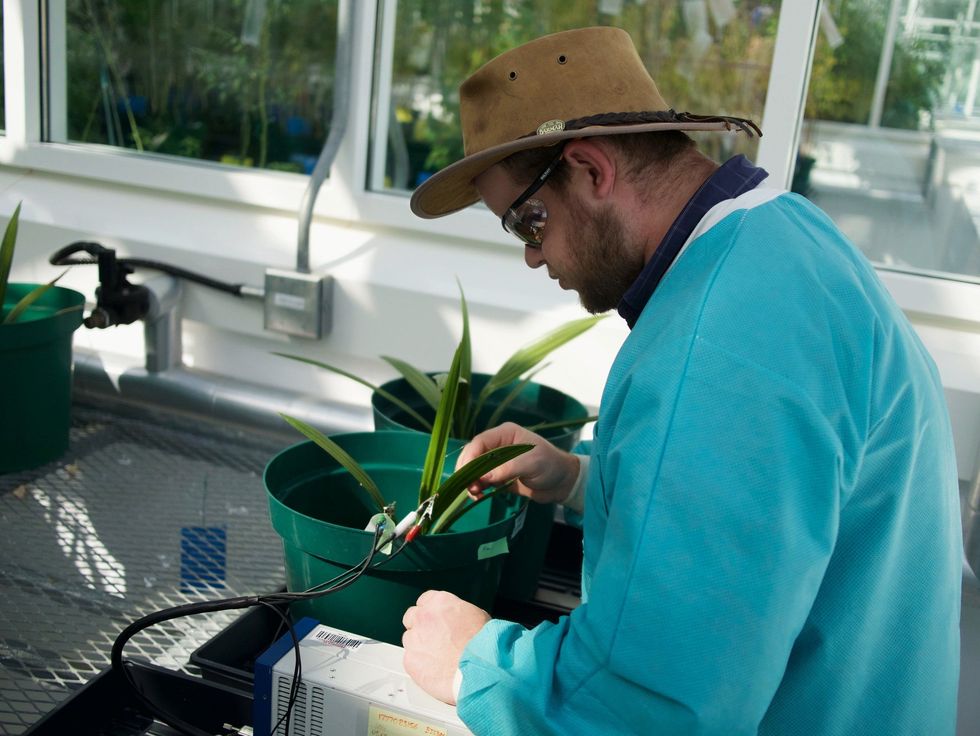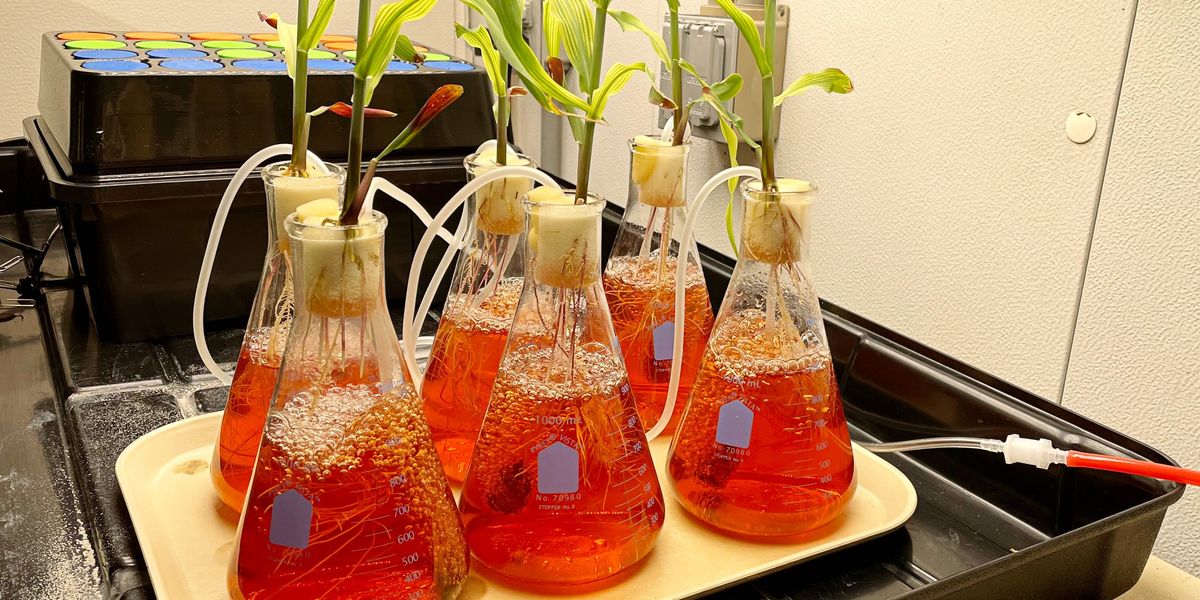This text is a part of our unique IEEE Journal Watch collection in partnership with IEEE Xplore.
As {an electrical} engineer, James Reynolds didn’t count on to work so intently with crops. However in a approach, his ancestral historical past and his private historical past have lengthy been main him to his ongoing analysis that leverages bioelectricity to raised perceive plant well being.
Reynolds’ household has farmed land in North Carolina for greater than 300 years. He’s a most cancers survivor who’s fascinated about well being and giving again to society. And the COVID-19 pandemic gave him loads of time to intently analyze crops he grew in his grandparents’ basement.
In a forthcoming paper to be revealed in IEEE Transactions on AgriFood Electronics(TAFE), Reynolds and fellow researchers at North Carolina State College explored how plant tissue’s impeding {of electrical} present could be monitored to determine crops below stress with relative immediacy—lower than an hour, in some circumstances.
“We’ve achieved our greatest on this paper to create an actual, relevant measurement that provides a brand new dimension to the image of what’s occurring with a plant,” says Reynolds, who’s a postdoctoral analysis scholar at NC State’s iBionicS Lab and first creator of the paper. “Our purpose is to present extra instruments to plant biologists, [Internet of Things] makers, and anybody else concerned in good farming or involved with crops.”
Steady, real-time monitoring of plant stress might make it doable to sluggish or forestall crop harm earlier than crops die—and so the potential purposes in good farming and precision agriculture are diverse.
This info might, for instance, make it easier for plant phenotyping researchers to match how totally different crops reply to water shortages, serving to these researchers develop drought-tolerant crops. Farmers might assess a plant’s water standing straight—somewhat than counting on oblique measurements like soil moisture stage or lagging indicators like yellowing leaves—and shift watering schedules for larger crop yield.
Making a Stress Monitor for Crops
Bioimpedance, which measures how dwelling tissues reply to an alternating present or voltage, is already utilized in medical instruments to evaluate varied physiological markers within the human physique. Plant bioimpedance is a extra nascent examine, nevertheless it’s no much less helpful: {The electrical} conductivity of a plant is equally affected by components together with the plant’s water content material.
So by making use of a present to a plant and measuring the ensuing voltage, after which calculating the impedance (voltage divided by present), researchers can assess whether or not a plant has a wholesome stage of hydration. When water ranges in a plant are decrease, so is the ion focus—which means the resistance, and due to this fact the bioimpedance ranges, will likely be larger.
 James Reynolds first seen the correlation between biompedance and water motion whereas finding out palm crops.North Carolina State College
James Reynolds first seen the correlation between biompedance and water motion whereas finding out palm crops.North Carolina State College
On this new work, the researchers targeted on corn and soybean crops, given their significance to the worldwide economic system and meals provide. They connected 27-gauge needle electrodes made from platinum and iridium to the crops, together with a commercially obtainable potentiostat to ship present by the crops. The researchers measured impedance from 5 hertz to 500 kilohertz, however they targeted on 5 Hz impedance for this paper as a result of “it corresponds nicely with the extracellular fluid drying up, which is an efficient proxy for drought stress,” Reynolds says.
The crew simulated drought situations by exposing crops to polyethylene glycol—a polymer usually utilized in experiments to induce water deficit—or by withholding water, then despatched a present by the crops. The ensuing adjustments in bioimpedance readings, the researchers discovered, in a short time mirrored physiological adjustments within the crops.
When utilizing the polymer to induce drought, crops’ bioimpedance measurements shot 25% p.c larger in lower than an hour. An identical sample held when withholding water, with these crops’ bioimpedance readings rising inside a couple of hours. Evaluating these readings with imaging, soil moisture, and leaf relative water content material backed up the impedance measurements.
“The outcomes are very constructive,” says Danilo Demarchi, editor-in-chief of IEEE TAFE and professor at Politecnico di Torino’s Division of Electronics and Telecommunications, whose analysis is in good digital methods for agri-food. At “the second, all of the implications [of plant bioimpedance] are nonetheless not demonstrated, so a piece for understanding extra deeply the knowledge that plant bioimpedance can deliver is of nice curiosity.”
Demarchi notes that bioimpedance purposes are each easy and cheap to implement, making it engaging to be used in precision agriculture. They may, he added, even be utilized in live performance with different sensors that measure components like ambient mild, temperature, and soil moisture.
“When somebody has a cardiac downside the emergency room offers them an EKG; in case you’re severely dehydrated, they’ll put electrical probes on you,” says Alper Bozkurt, a co-author of the paper and co-director of NC State’s Middle for Superior Self-Powered Techniques of Built-in Sensors and Applied sciences (ASSIST Middle).
“It’s already taking place with people, and now the query is: How will we do it with crops?” Bozkurt continues. “Particularly with inhabitants progress and folks shifting out of rural areas, we have to do one thing as engineers to assist deliver wholesome meals to individuals’s tables. That’s been our motivation.”
Sensible Farming
Certainly, good farming, precision agriculture, and associated fields have attracted extra analysis exercise in recent times, as urbanization and local weather change spark considerations about persevering with to develop a world meals provide. As such, plant biologists and engineers are coming collectively extra steadily; as Reynolds notes, on this paper his fellow researchers embrace not solely different NC State engineers but in addition scientists from the college’s Plant Sciences Initiative.
Bozkurt served as Reynolds’ advisor for his doctoral research, and in 2016 they started presenting work on novel nanocellulose-based electrodes that they developed to watch plant electrochemistry with out harming the plant itself. Reynolds factors out they weren’t ranging from scratch, nonetheless.
“We discovered that plant biologists have truly been working what had been basically early electrical impedance measurements on crops for a very long time, however they couldn’t do it on dwell crops,” Reynolds says. “They knew quite a bit about patterns primarily based on these sections of crops, however they didn’t have {the electrical} engineering abilities to grasp interpretations, and admittedly we didn’t have the instruments but.”
Now electronics are smaller, electrodes are extra superior, and the Web of Issues has fueled speedy enlargement of networking applied sciences.
“With the capabilities now, and the way a lot expertise has modified, we as engineers are in a position to collaborate a lot extra intently with plant biologists,” Reynolds says. “That is the place all of it comes collectively.”

